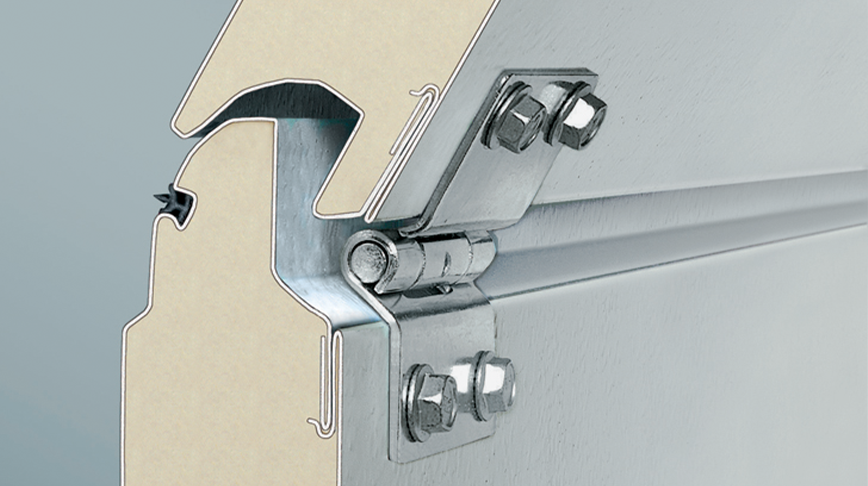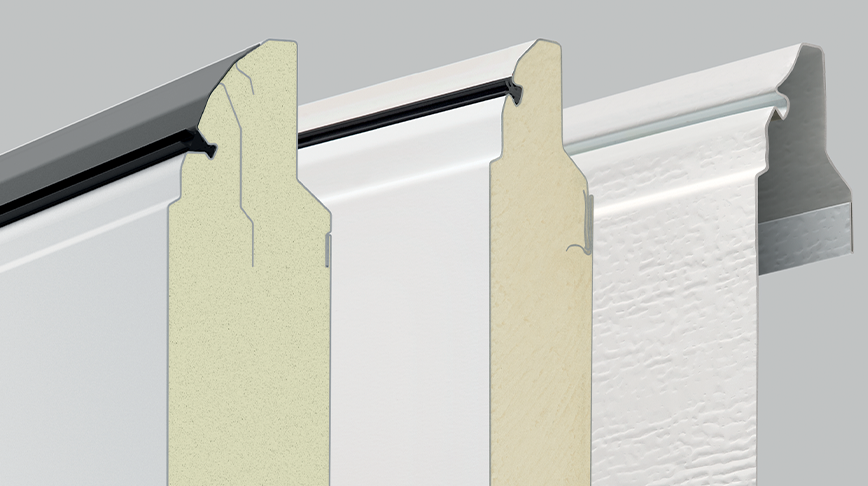As leading suppliers and installers of garage doors across the South, Freelance Entry Solutions are familiar with insulated garage doors. Here we give some insight into the properties of insulated garage doors and point you in the right direction when it comes to finding the perfect solution for your home.
Garage Spaces Are Designed to Be Ventilated
The definition of a garage is a building for housing a motor vehicle or vehicles and historically, they have been designed to ventilate potential fumes from vehicles, and other potentially harmful substances such as oils and petrol for garden machinery.
Ventilation continues to be very important – parking wet vehicles in sealed garages can result in a damp and humid garage affecting vehicles and stored belongings. This is why when we install insulated garage doors we offer customers measures that can assist, such as simple vents built into the door, or for remote automated garage doors, the option of humidity sensors which slightly open the door to ventilate when required.
Because of the points above, garages have never been designed to be insulated, and neither have garage doors up until more recently. Furthermore, there are no building regulations requiring a garage to be insulated.
Although a better sealing garage door means fewer drafts and cold air, the way in which different mechanisms operate can limit their ability to seal, with some designs such as sectional and roller doors more effective at sealing. It is important to note that even the best insulated garage doors do not ensure an air or watertight seal, certainly not to a level that you would expect from a product such as a front door.
The Changing Use of Garage Spaces
Year after year we see new car models gaining inches in size, making parking the car in the garage a risky and challenging task, or as in many cases, simply impossible. So it’s no surprise that over half the garages in the UK are never used for vehicles and this number is increasing. Garages have become more integral to the house providing much-needed storage space, used frequently as utility rooms, workshops or hobby rooms, as revealed by an article published by the RAC.
With 2020 seeing millions working from home, more homeowners than ever before are trying to utilise space around the house better, including converting garages to offices, workspaces and home fitness gyms. Insulated doors help to make these spaces more usable offering a degree of insulation, air resistance and water resistance.
Why Choose an Insulated Garage Door?
Insulated garage doors help create a more usable space, but benefits extend to integral garages where rooms of the main house directly adjoin or link to the garage. Many people will be familiar with the room directly above the garage being colder than those above the main house but do notice an improvement after insulated garage doors have been fitted.
Even if a garage does not have central heating, an insulated garage door along with a small heater will warm up quickly and retain that warmth for longer, just taking the edge off to make work comfortable or tinkering with whatever your hobby more enjoyable.
For those who do keep vehicles in the garage, it’s often the case that the car is valuable and of course their pride and joy, so insulated garage doors that do provide greater protection are a fantastic investment.
Other Factors to Consider Aside From the Door When Insulating a Garage
- Windows – windows in garage doors are usually only single or double pane polycarbonate which is not sealed and filled with Argon gas like double glazed windows around the home. Therefore, window options will slightly affect the U-value of a garage door.

- Doorframes – a lot of the focus is on the insulation achieved from the garage doors panel itself, but people overlook the weakest link in terms of insulation, the frame. Required for every door, frames generally have little or no insulation whatsoever. So when we survey and specify an insulated garage door we aim to take measures such as minimising the exposed surface area of a frame and provide options off floor thresholds and thermal breaks between the steel frame and the structural opening.

- Structural Openings – the performance of the door is equally reliant upon the build quality of the opening and materials to which the door frame will be fitted. A garage door must be installed level and plumb so a structural opening with a flat level floor, flush and plumb brickwork will result in tighter gaps and better sealing.
- Design & Correct Door Specification – ensuring the correct size, type and spec of garage door to suit the structural opening is fundamental in getting the best from a door. An experienced garage door company will foresee potential issues that may hinder a particular type of door, and offer solutions or alternatives to ensure the door will meet expectations. Working with architects and builders in the early stages of a new build can significantly optimise the insulation of a garage door as well as it resistance to air and water ingress.
What about U-Values?
Defined by NBS, thermal transmittance, or U-value, is the rate of transfer of heat through a structure (which can be a single material or a composite), divided by the difference in temperature across that structure.
Fortunately, you don’t need to know what U-value means in order to compare one insulated garage door to another; you just need to remember that lower is better! That said, you do need to consider that the u-value doesn’t account for the size of the garage door – so, if you’re comparing the U-values of two garage doors, check the dimensions of the doors upon which the U-value has been calculated are of similar size. If one is markedly larger than the other then they will not be an accurate comparison.
Which Type of Insulated Garage Doors Deliver the Best Insulation?
Freelance Entry Solutions have a variety of insulated garage door solutions on offer, delivering insulated qualities to customers throughout the South.
Up & Over Doors – Not Ideal for Those Looking for Insulation!
Unavoidable gaps and a pivoting mechanism with weight and size limitations mean the one piece up & over garage door has never been viable as an insulated door. Manufacturers have tried with the addition of lightweight insulated boards that retrofit to the back of the garage door but all have proven to be ineffective, both in terms of cost and performance.
There is an exception to the rule which comes from the Italian manufacturer Silvelox in the form of a beautiful bespoke handcrafted garage door that combines the strength of steel with engineered veneered timber. At 80mm thick and with a good seal on all four sides you will have an incredibly secure and insulated up and over timber garage door, but this precision and quality obviously comes at a cost.
Roller Doors
The following is based on the new generation of roller doors constructed using individual steel or aluminium slats with a rigid foam core, sliding together to form the complete roller curtain. As a general rule they come in two sizes; a larger slat version (approx. 18mm thick by 78mm in height) and the smaller compact slat version (approx. 8mm thick x 50mm in height). They might vary slightly from brand to brand but will generally be categorised by these two sizes. Caution is advised because it can be difficult to distinguish between the two versions from a website, brochures, or even in person - all too often people are unwittingly sold the thinner version only to be disappointed.

It’s no surprise that domestic roller door companies will promote their doors as insulated, and it’s often assumed this latest generation of roller garage doors provide good levels of insulation. But with a U-value of only 5.2W/m2.K at best, some people question whether these roller doors can be truly classed as insulated. The fact is there is no definitive U-value threshold or criteria that officially classifies a garage door is insulated - so it’s about perspective. You certainly wouldn’t accept a U-value of 5.2W/m2.K for a door or window on your home, not to mention building regulations wouldn’t allow it, but for a garage door where insulation is a luxury and not a requirement, we think it’s reasonable.
To elaborate, if you compare a roller door against a basic one piece up and over garage door, the roller door will provide a noticeable difference with seals helping prevent draughts and the foam core of roller curtain taking the edge off on those cold days. However, when compared to doors such as the steel sectional, side hinged and overlap, which uses 40mm - 70mm thick insulated door panels, it’s no competition and the roller door is inferior.
Similarly, if you put the two versions of roller door head to head the larger 18mm thick roller door will obviously come out on top of the thinner 8mm version.
Insulation Limitations of Roller Doors
But it’s not only the thickness of the slats that limit a roller doors ability to insulate. Manufacturers stipulate a small gap is required along the top of the door between the slats and the back of lintel (or roller box cover) to eliminate scratching as it opens. There is no effective rubber seal when the door is closed and is, therefore, a weak spot when it comes to insulating. We are not saying this is poor design or a problem, in fact for some people this useful in providing ventilation – it simply about managing expectations.
Roller doors have many great features and benefits, especially for those looking for a space-saving garage door. Just be aware of the limitations when it comes to insulation.
Best Choice For Insulated Doors - Sectional Garage Doors


Sectional garage door mechanisms allow for much larger and thicker panels to be used and are without question the top choice for those who are looking for a truly insulated door.
The majority of insulated sectional doors all use a similar panel design, a rigid insulating foam core (between 20-70mm thick) sandwiched between steel panels. Combined with a mechanism which closes the door against seals on all four sides means you benefit from U-values as low as 1.4W/m2.K from a 42mm sectional, or better still 1.0W/m2.K from the 70mm highly insulated sectional with a unique thermal break design. The optional addition of a thermal frame kit with secondary top and side rubber seals further improves the U-value by up to 15%
For those looking for the best product to insulate their garage, sectional garage doors are hard to beat.

Side Sliding Garage Doors
Side sliding garage doors were traditionally timber, they were heavy to push and pull, the bottom of the panels would rot and floor tracks would fill with dirt and water, eventually rusting out. Then the evolution of the early up and over garage door mechanism took hold followed by roller door and sectionals and so on, the side sliding door has become almost obsolete.

That is until more recently when leading manufacturers redesigned the side sliding door for today’s domestic garage door market. Taking the 42mm insulated steel panels from their sectional range it offers strong, low maintenance, and well-insulated alternative to timber. They developed a new surface fixed aluminium sliding track and rail system, designed to eliminate the inherent problems associated with the original.
One of the most significant benefits was the sectional panels have an anti-pinch design preventing fingers becoming trapped as the door folds around the corner – anyone who has had a side sliding door is likely to understand the pain. This feature also guarantees complete safety and compliant with today’s regulations. Small details such as small rubber gaskets between the panels as well as around the frame all help the side sliding sectional achieve Class 2 for wind load, water and air permeability, and a U-value of 1.9W/m2.K for a door 4.3m wide x 3m tall the door to. All in very impressive stats for side sliding garage door that’s is capable of sizes up to 6.5m wide x 3m tall.

Ok so it’s not for everyone, but those that are willing to forgo storage along one side of the garage will appreciate the advantages and simplicity of the sliding mechanism.
Side Hinged Garage Doors
The demand for side hinged garage door has increased in recent years which seems to coincide with the changing ways in which people use the garage space, and it’s easy to see why - the convenience of being able to come and go with ease via a pedestrian hinged door while retaining the ability to open both doors for full garage access on that rare occasion.
Side Hinged garage doors come in many forms but if you are looking for insulation then the steel side-hinged door sets from the likes of Hormann, Strongdor and Teckentrup will impress. They combine the proven 40mm foam insulated sandwich panel from the sectional doors with an extruded aluminium or steel frame, fully adjustable hinges, and secure locking systems. Depending on model and spec you can expect U-values of 3.3W/m2.K for a simple steel door set from Strongdor down as low as 1.4W/m2.K for the Hormann NT80 with thermally broken aluminium frame. The strength and rigidity of this design allow for door sizes of up to 3m in width.

Wooden Options
If you happen to prefer the warmth and beauty of natural wooded side hinged doors then Woodrite’s solid timber side hinged is the range for you. Our close working relationship combined with Woodrite’s flexibility allows us to create a pair of insulated wooden door tailored to you.
Overlap Garage Doors
The innovative Overlap garage door is a perfect solution if you want a space-saving trackless system like that of the roller door, but prefer the impressive insulation of a sectional door. The Overlap shares many of the characteristics as the sectional door - insulated 40mm or 70mm sandwich panels that press closed against rubber seals along all four edges, achieving U-values close to that of a sectional of between 1.5W/m2.K and 1.1W/m2.K depending on model and spec.

What makes the Overlap unique is the way it operates. Two insulated sections open vertically without protruding outwards and as one reaches the fully open position the other neatly slides in and under the first, halving the distance required inside the garage when open. This self-supporting configuration eliminates the need for unsightly tracks suspended from the ceiling and maximising valuable garage space.
Get In Touch about Insulated Garage Doors
If you are looking for a local company with experts in the supply and installation of garage doors, then please do get in touch. Our surveyors and fitters are fully trained and experienced professionals and we focus on only offering the best products on the market to ensure that garages are left as insulated as the products allow for.

